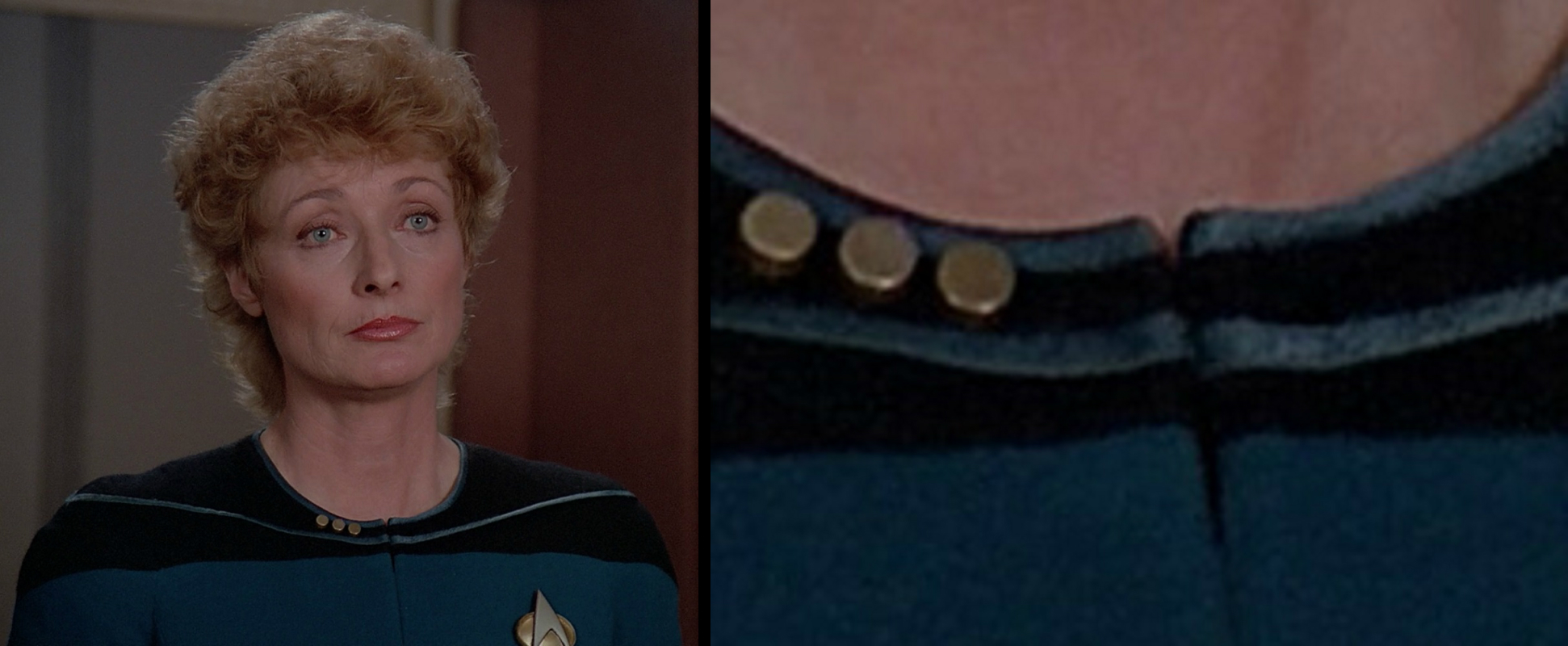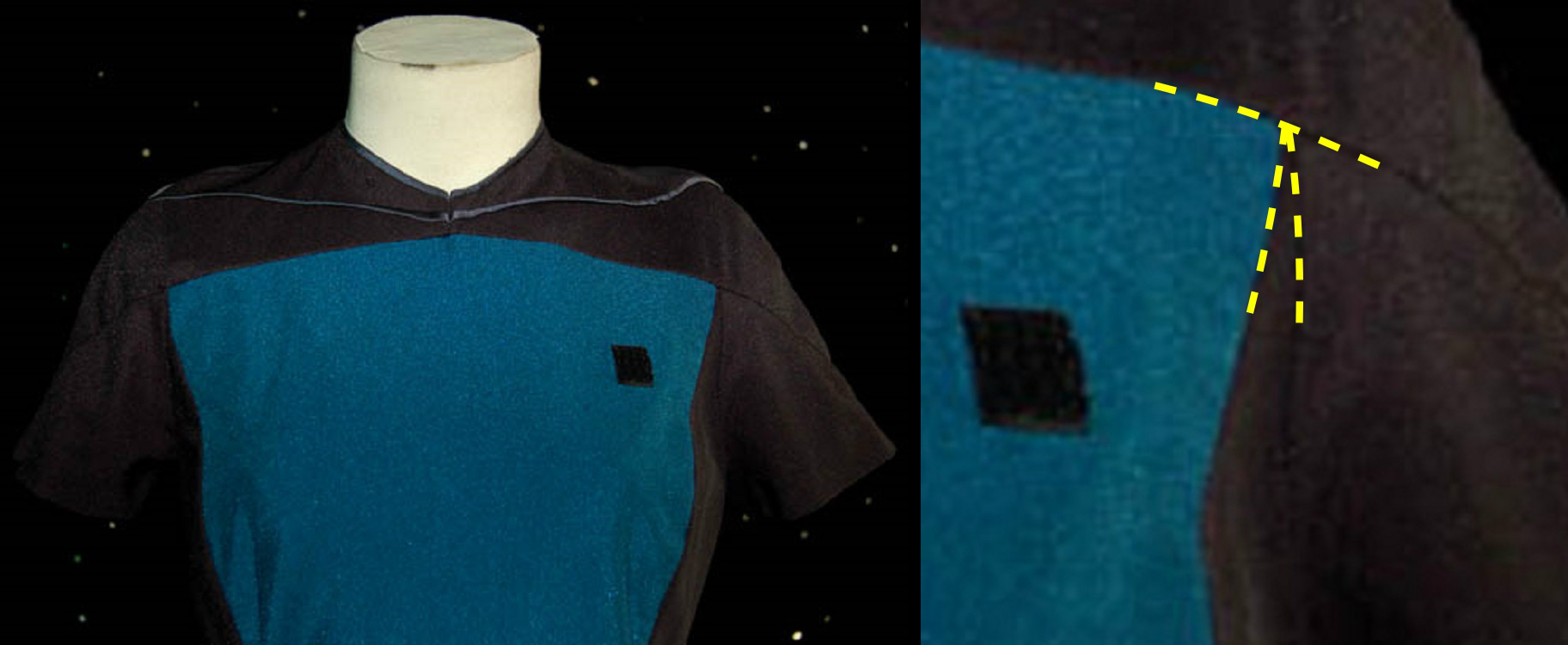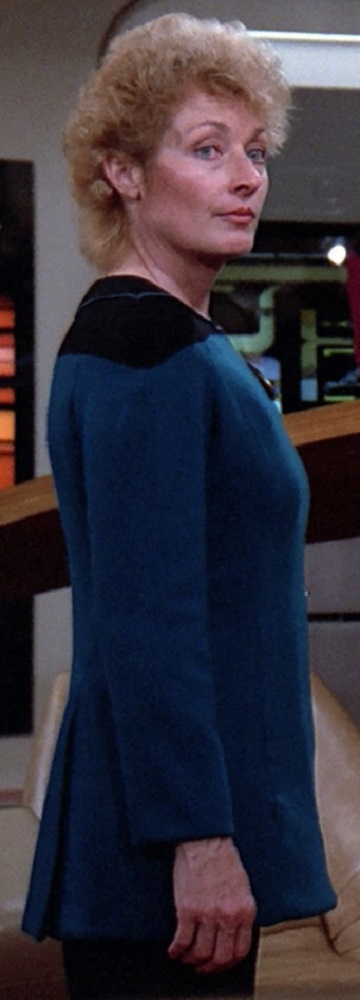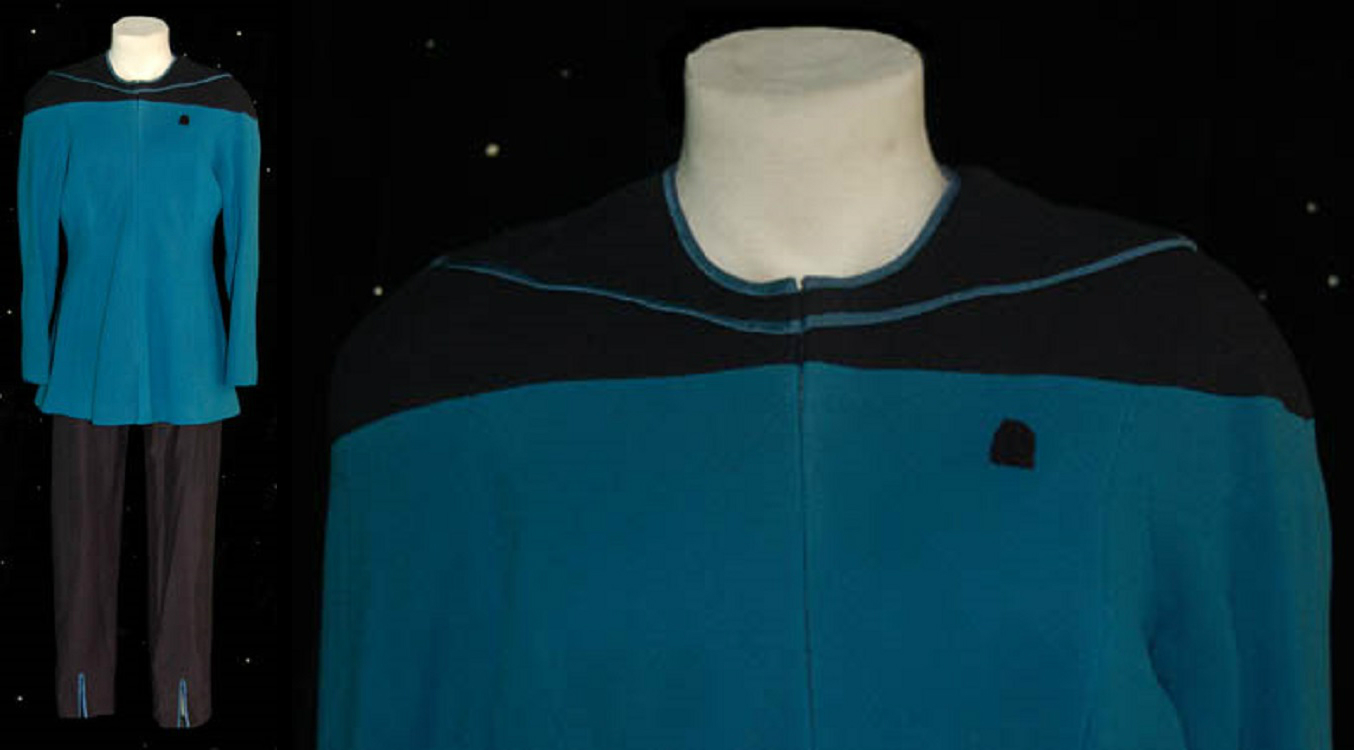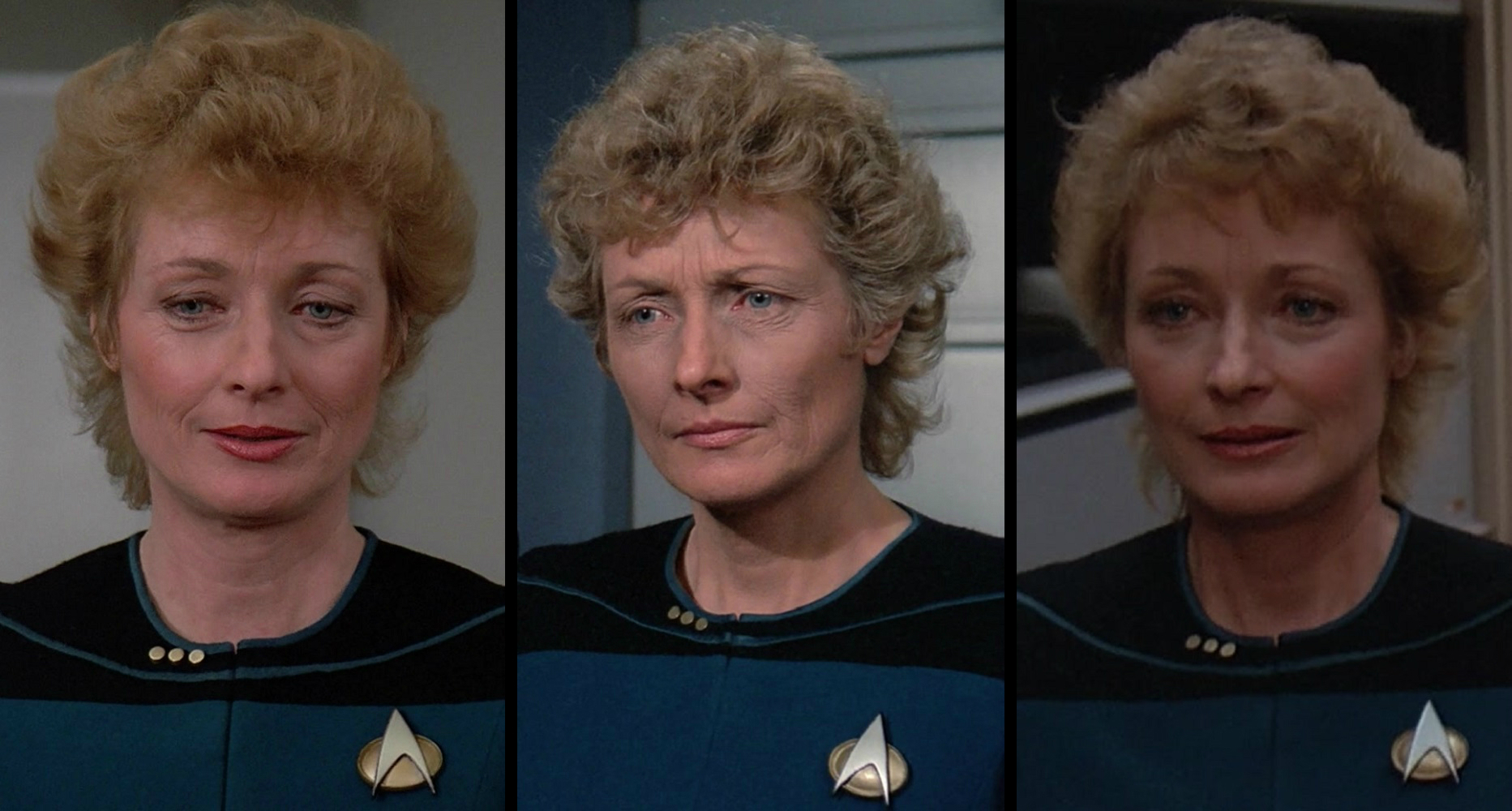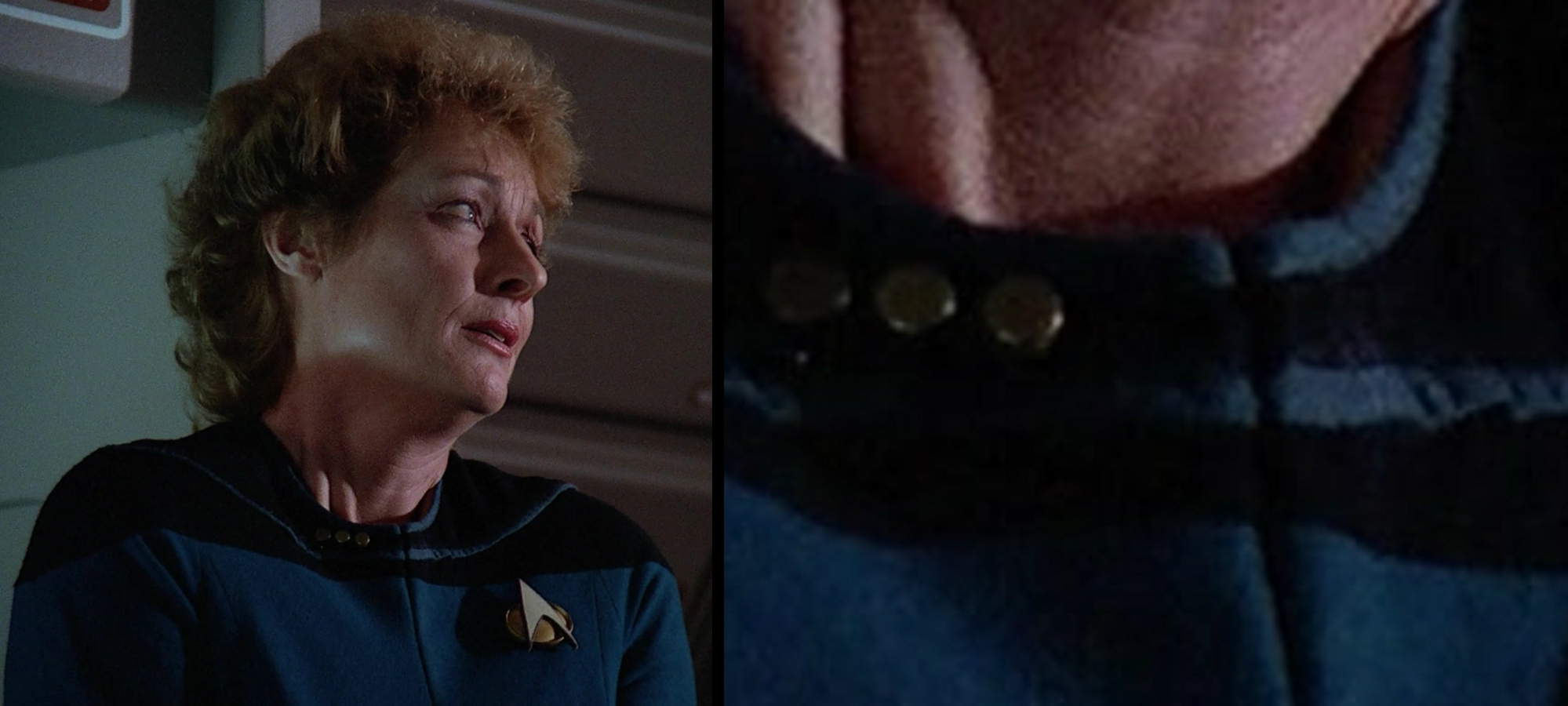After the first episode of season two, Dr. Pulaski wore what I refer to as “versions 2, 3, and 4” of her medical smocks for the first half or so of the season.
Versions 2-4 are all very similar, so we’ll take a look at version 2 first to establish what they all had in common. Afterward, I’ll point out the specific differences between the three versions.
Also, I won’t be rehashing the more general uniform characteristics (neckline/yoke trim, yoke construction, etc.) but will instead be discussing the unique aspects of the subsequent medical smocks.
The neckline of version 2 was noticeably wider (a bit more analogous to the early TNG jumpsuit necklines in that regard), and not quite as deep in the front.
Interestingly, the contour of the yoke piping on this second version of the TNG medical smock appeared to be slightly different; it sort of “swooped” upward in a gentle U-shape.
This was even more apparent when Dr. Pulaski was angled slightly away from the camera.
One could most easily observe the differing yoke piping contours when Dr. Pulaski was standing in-frame with another character who was wearing a standard TNG jumpsuit.
Although the neckline width on this second version was more analogous to the corresponding TNG jumpsuit’s, the center front yoke depth appeared to be more consistent with first version.
The body panels on versions 2-4 of the medical smock appeared to be analogous to those on the TNG skants, albeit all medical/sciences “teal” instead of black side panels and sleeves.
There were two slight variations of those upper body panel seam lines, though.
On the first, the front/side front seam line didn’t meet at the yoke/armscye seam line (forming a 3-way “intersection” like the aforementioned did); instead it met the armscye about 1 ½” lower – more like a conventional princess seam on a ladies’ garment.
On the second, the top of the front/side front seam was a hair “off” – that is, it was about ⅛” to ¼” away from the yoke/armscye seam line.
I believe on this particular (second) variant, the seams were intended to properly align, but things shifted a bit during the construction process and the end result was what you can see above.
(Having made quite a few TNG skants and medical smocks now, I can personally attest to the occasional difficulty of properly aligning those seam lines!)
I, personally, consider the first example to have been the “ideal” version 2; the second (with the more conventional princess seam) appears to have been intentional, but it only appeared briefly before it was quickly abandoned, and the third appears to have simply been a result of human error.
Nevertheless, they all seem to otherwise be identical; despite the difference in the front seams, I’ll be referring to all three of these as “version 2,” although if you wish to refer to them individually for some reason, I suggest “version 2a,” “version 2b,” and “version 2c.”
Unlike version 1, there were no bust darts on version 2; as with the TNG skants, the additional bust fullness was incorporated into the side front body panel.
Also unlike version 1, there was no waistband, and there appeared to be no pockets.
However, an auction listing for this particular uniform described “zip pockets on the sides of the stomach” …
Although I never observed the use of these pockets (or even the existence of the pockets themselves) in the show, I came across this photo of a Dr. Pulaski uniform on YourProps by “Thot Pran,” and sure enough, if you zoom way in, you can see a little zipper pull on the front side seam, presumably opening into a pocket!
While there were no lower side openings like version 1 had, there were two back vents.
Considering the front seam intersection and the back vents, I believe costume designer Durinda Rice Wood may have used the existing TNG skant pattern as a base – or at least half of it, tweaking the pattern to make the garment symmetrical.
Version 2 was also appeared to be front-closing.
Indeed, an auction listing for one of these uniform styles described it as zipping up the front.
Version 2, specifically, had no lower openings/slits/etc.; except for the two back vents; the body panels were all sewn closed all the way down to the hem.
As always, the armscye was rounded and had the raglan-style “silhouette.”
Oddly though, the shoulder slope on this version of the smock didn’t appear quite as smooth and rounded as the others (or other characters’); observe the “bump” about halfway between her neck and upper arm.
Perhaps this version had no shoulder pads, or someone forgot to attach them before filming?
As with version 1, the sleeves were noticeably looser than the early TNG jumpsuit’s.
The lower sleeves were looser, as well.
And it looks like this version of the medical smock might have been lined, but it’s tough to say for sure; it could have just been a shadow …
Now, let’s move on to a quick look at versions 3 and 4!
Version 3
Again, both versions 3 and 4 seem to have been identical to version 2, except for the characteristics I’ll be outlining here.
The yoke piping contour on version 3 was perhaps the closest the TNG medical smock ever came to mimicking that of the early TNG jumpsuits …
(At least, I think this one was version 3! She would occasionally swap back and forth between the variants in the same episodes, and the distinguishing details weren’t always visible in the shots …)
The version 3 yoke depths appear to have slightly varied at the center front; some appear to have been slightly deeper than others.
Perhaps the most notable (or at least, the most easily observable) unique characteristic of version 3 was the multiple slits at the bottom of the smock; the bottommost couple inches or so were left open at the center front and the side front panel seams.
To more easily differentiate these details, version 2 is pictured below on the left, and version 3 is on the right.
Version 4
Version 4 was very similar to both versions 2 and 3, with the primary difference being that the yoke was considerably deeper.
(If you’ve read my TNG jumpsuit analysis, this should come as no surprise; as you may recall, costume designer Durinda Rice Wood gradually deepened many of the yokes over the course of the season.)
The back yoke, in particular, was extremely deep – far deeper than any other early-TNG-era uniform!
It was a truly bizarre choice …


Other than the radical changes to the yoke, a primary distinguishing characteristic of version 4 was that unlike on version 3, there was a lower front slit but no side slits.










